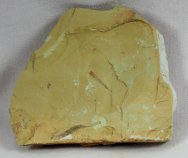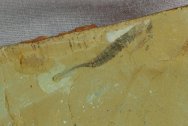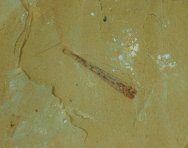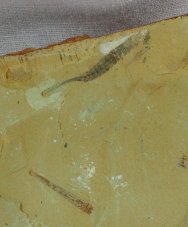Tanglangia
longicaudata
Phylum Arthropoda,
Megachira
Selkirkia sinica
Phylum Priapulida
Geological
Time: Early Cambrian, (~ 525 million years ago)
Size: Taglangia:
15 mm long; Selkirkia: 13 mm long; Matrix: 65 mm by 55 mm
Fossil
Site: Chengjiang Maotianshan Shale, Quiongzhusi Section, Yu’anshan
Member, Heilinpu Formation Mafang Village, Anning, Kunming, Yunnan Province,
China
Code: CJF931
Price: Sold
| 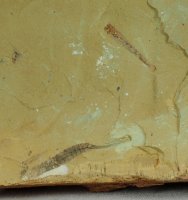 Description:
This unusual arthropod is known as Tanglangia longicaudata. With
the discovery of the Chengjiang Biota by Hou Xian-guang in 1984,
the world became aware of a great storehouse of material from
early in the Cambrian Description:
This unusual arthropod is known as Tanglangia longicaudata. With
the discovery of the Chengjiang Biota by Hou Xian-guang in 1984,
the world became aware of a great storehouse of material from
early in the Cambrian 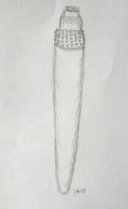 Explosion. The diversity of soft-tissue
fossils is astonishing: algae, medusiforms, sponges, priapulids,
annelid-like worms, echinoderms, arthropods (including trilobites),
hemichordates, chordates, and the first agnathan fish make up
just a small fraction of the total. Numerous problematic forms
are known as well, some of which may have represented failed
attempts at diversity that did not persist to the present day.
The specimen is a member of the “great appendage arthropods” known
as the opabinids after Opabinia from the Burgess Shale Fauna.
It is most closely allied with Jianfengia, the most primitive
of the opabinids. It differs primarily in having fewer segments
and a long telson. Explosion. The diversity of soft-tissue
fossils is astonishing: algae, medusiforms, sponges, priapulids,
annelid-like worms, echinoderms, arthropods (including trilobites),
hemichordates, chordates, and the first agnathan fish make up
just a small fraction of the total. Numerous problematic forms
are known as well, some of which may have represented failed
attempts at diversity that did not persist to the present day.
The specimen is a member of the “great appendage arthropods” known
as the opabinids after Opabinia from the Burgess Shale Fauna.
It is most closely allied with Jianfengia, the most primitive
of the opabinids. It differs primarily in having fewer segments
and a long telson.  The largest complete examples can reach 35
mm, with the telson in some cases being as long as the abdomen.
The taxon is unknown outside the Chengjiang Biota. This one is
incomplete, showing only the posterior half of this unusual arthropod
in greatest detail, although almost the entire specimen is represented;
a complete specimen has 13 body segments. The other specimen
is a member of the Priapulida. The priapulids are a group of
non-segmented worms whose modern-day examples can reach 30 cm
in length, and live in both shallow and deep marine sands as
carnivores. The terminal mouth bears cone-shaped projections
called scalids by which the worm would snare its prey. This taxon
is only known from Chengjiang. The largest complete examples can reach 35
mm, with the telson in some cases being as long as the abdomen.
The taxon is unknown outside the Chengjiang Biota. This one is
incomplete, showing only the posterior half of this unusual arthropod
in greatest detail, although almost the entire specimen is represented;
a complete specimen has 13 body segments. The other specimen
is a member of the Priapulida. The priapulids are a group of
non-segmented worms whose modern-day examples can reach 30 cm
in length, and live in both shallow and deep marine sands as
carnivores. The terminal mouth bears cone-shaped projections
called scalids by which the worm would snare its prey. This taxon
is only known from Chengjiang.
Also
see: Chengjiang
Biota Fauna List Chengjiang
Fossils
|
|



